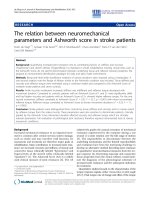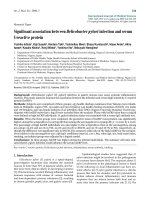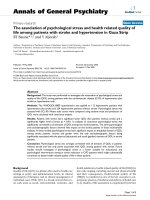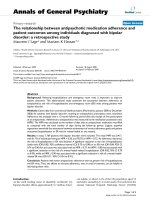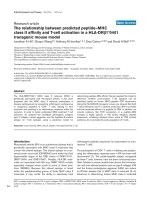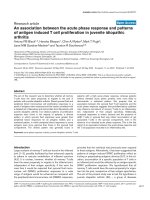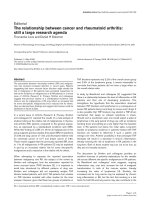Báo cáo y học: "The association between weight loss and engagement with a web-based food and exercise diary in a commercial weight loss programme: a retrospective analysis" pdf
Bạn đang xem bản rút gọn của tài liệu. Xem và tải ngay bản đầy đủ của tài liệu tại đây (203.63 KB, 7 trang )
RESEARCH Open Access
The association between weight loss and
engagement with a web-based food and exercise
diary in a commercial weight loss programme:
a retrospective analysis
Fiona Johnson
*
and Jane Wardle
Abstract
Background: The Internet provides a widely accessible platform for weight loss interventions. Automated tools can
allow self-guided monitoring of food intake and other target behaviours that are established correlates of weight
change. Many programm es also offer social support from the virtual community. The aim of this research was to
assess associations between engagement with self-monitoring tools and social support, and weight loss in an
online weight-control programme.
Methods: This paper describes a retrospective analysis of weight change among 3621 subscribers to a commercial
Internet-based weight loss programme. Participants were all subscribers (2979 women; 642 men) joining the
programme between July 2005 and November 2008 with two or more recorded weights spanning at least 28 days
of participation in the programme. Engagement was indexed with frequency of using online diet and exercise
diaries and with use of the social support forums.
Results: Programme engagement was associated with weight loss in both men and women after contr olling for
initial BMI and duration of participation. The three engagement variables accounted for 13% of variance in
percentage weight loss in women (p < .001) and 19% in men (p < .001). In analyses including all the engagement
variables, exercise diary use was an independent predictor of weight loss among men, but non-significant in
women. In contrast, use of the online forums was associated with weight loss in women but not in men. Among
participants who were overweight or obese, those in the highest tertile of engagement with food diaries (vs the
lowest) were more likely to achieve clinically significant (> 5%) weight loss (men: OR = 3.45 p < .001; women: OR
= 5.05 p < .001). Being in the highest tertile of engagement with exercise diaries was associated with clinically
significant weight loss in men (OR = 3.48 p < .001) and, less strongly, in women (OR = 1.46 p < .05).
Conclusions: Use of self-monitoring tools and participation in online support are predictive of weight loss in the
context of a commercial, online weight control programme.
Introduction
The desire to lose weight is widespread in affluent western
countries and efforts to achieve a neutral or negative
energy balance are appropriate both for overweight/obese
adults who are trying to lose weight and those of normal
weight who w ish to a void weight gain [1,2]. Alo ngside
services offered by healthcare providers that are typically
directed towards more severely overweight groups, a wide
array of commercial weight loss programmes is available
[3]. People seeking assistance with weight control can
choose from programmes using a variety of formats
including books, DVDs, Internet sites and weight loss
clubs, and offering a ran ge of tools, services and types of
support. This makes it possible for consumers to match
the ir preferred appr oach to weight control to the ser vice
of a particular provider. Research into the mechanisms of
* Correspondence:
Cancer Research UK Health Behaviour Research Centre, Department of
Epidemiology and Public Health, University College London, Gower Street,
London, WC1E 6BT, UK
Johnson and Wardle International Journal of Behavioral Nutrition and Physical Activity 2011, 8:83
/>© 2011 Johnson and Wardle; licensee BioMed Central Ltd. This is an Open Access article distributed under the terms of the Creative
Commons Attribution License ( /by/2.0), which permits unrestricted use, distribution, and
reproduction in any medium, provided the original work is properly c ited.
operation and effectiveness of these commercial
programmes has been sporadic and limited, with many
pop ular appro aches used by large numbers of customers
worldwide having had little scientific evaluation. However,
where research has been carried out, the results have been
broadly positive, indicating that commercial programmes
can be successful in assisting with weight control [4-6]
while meeting users’ nutritional needs [7,8].
As online facilities have become more accessible, there
has been increasing use of the Internet as a platform for
both commercial and health service weight loss pro-
grammes [9]. Internet programmes have been shown to
achieve weight loss outcomes comparable to face-to-face
interventions that use similar tools [10-12]. The potential
benefits of online interventions include automatic moni-
toring of usage patterns among participants [13]. They
may also provide considerable savings of time and cost [9];
in particular reducing demands on heal th professionals
and therapists. Progr ammes typically include a variety of
features, and allow participants to be selective about the
tools they use. Several studies have examined which fea-
tures of Internet weight loss programmes are associated
with successful weight loss in the context of randomised
controlled trials (RCTs) or formal research studies
[9,13,14], but a recent systematic review concluded that
not enough was known about components of web-based
interventions associated with effectiveness [15]. It has also
been suggested that patterns of use and outcomes differ
between RCT participants and non-trial users o f web-
based programmes [16], and although many people seek-
ingtoloseweightdosowithouttheformalsettingofa
therapeutic intervention or clinical trial, few studies have
examined utilisation patterns and weight loss in self-
guided ‘direct-to-consumer’ commercial services [17,18].
Two features of internet weight loss programmes that
have been associated with weight loss are use of self
monitoring tools and peer social support. Self-monitoring
of weight and target behaviours has long been recognized
as an important tool for weight control [19,20], and keep-
ing diary records of diet, exercise or weight is associated
with successful weight loss and weight maintenance
[14,20-22]. Reports from programme participants also
support the value of self-monitoring [23]. It appears to be
the act of self-monitoring rather than the exact approach
that is valuable for weight control, since there is little
effect of recording method, for example electronic versus
paper diaries [24], the degree of detail in the records kept
[25], or whether or not participants receive training in
recording accuracy [26]. Peer social support is similarly
perceived to be valuable by many of those using internet
weight loss programmes and may enhance outcomes and
commitment to the programme [14,27-29], alt hough
active involvement in peer chatrooms and message for-
ums has been reported to be low [17].
In this study we exa mined associations between several
aspects of programme engagement and weight loss in
3621 people enrolled in Nutracheck: a direct-to-consumer,
Internet weight loss programme centred around self-mon-
itoring of diet and physical activity and provision of social
support through an online message forum. The analysis
tests the hypothesis that greater engagement either with
self-monitoring tools or the social support forum will be
associated with greater weight loss among all participants
and clinically significa nt weight loss in overweight and
obes e participants. Men and women were analysed se pa-
rately since other studies have found gender differences in
use of online facilities and factors associated with weight
loss success (e.g. [30,31]).
Methods
The programme
Nutracheck provides a platform for completing food and
exercise diaries online, in return for a monthly subscrip-
tion charge. The service is a self-help tool assisting the
user in recording diet and exercise and charting their
progress towards a target weight. The user registers
online and enters perso nal information about height,
weight, activity lev els, and desired amoun t and speed of
weight loss. The system then sets a personal daily cal-
orie target (Harris-Benedict equation [32]) adjusted for
activity level [33] an d the individual’ schosenrateof
weight loss up to a m aximum of 2l bs (0.9 kg) a week.
The user is advised to use a daily food diary which links
to a database of over 40000 branded and unbranded
food items, automatically calcul ating an estimate of cal-
orie intake. A daily exercise diary encourages additional
physical activity by setting a target to expend a mini-
mum of an extra 200 calories/day, and calculates an
estimate of expenditure from t he activity records. The
core concept of this web-based programme is that
visually demonstrating energy balance helps the user
learn how to adjust their diet and lifestyle to lose
weight. The website also includes tools to support beha-
viour change such as weight charting software, access to
health and nutritional information, and an active online
social community to provide support and motivation.
Inclusion criteria
A retrospective analysis was carried out based on self-
reported weight loss data from participants joining the
programme between July 2005 and November 2008 who
metinclusioncriteriaof:i)payingatleastonemonth’ s
subscription to the site and ii) recording two or more
weights spanning a period of at least 28 days (to exclude
those whose participation in the programme had been
too short to give reliable weight change data). All subscri-
bers had given their permission for use of ano nymised
data when signing up with the programme.
Johnson and Wardle International Journal of Behavioral Nutrition and Physical Activity 2011, 8:83
/>Page 2 of 7
Measures
Percentage weight loss. This was calculated using the
first and last weights recorded on the website and was
the primary outcome variable. The distribution of this
variable showed moderate departure from normality
(men: skewness = 0.7 [SE = 0.1], kurtosis = 2.2 [SE =
0.2]; women: skewness = 1.0 [SE = 0.5], kurtosis = 2.8
[SE = 0.9]). Exploratory analyses carried out using a
square root transformation on the dependent variable
showed similar results and significance levels to those
using the untransformed variable, and therefore untrans-
formed data was used in the analyses presented here to
facilitate interpretation. Duration of programme use.
This was calculated as the nu mber of days between first
and last recorded weight. Number of days diet/exercise
diaries used. These are raw figures which are adjusted
for duration of programme use in multivariate analyses
to indicate engagement with the programme. Online
forum posts. As forum use was not normally distributed,
with the majority of participants not posting any mes-
sages and a few posting many times a day, a dichoto-
mised form of this variable was used in all multivariate
analyses (any messages posted vs no messages posted).
Weight and height. These were self-reported on the
website at registrati on and weight subsequently updated
by the user. Height and weights were used to calculate
initial and final Body Mass Index (BMI = weight in kg/
height in m2). Sex and age. These were routinely
recorded on registration with the programme.
Analysis
Multiple regression and logistic regression were used to
compare percentage weight loss and clinically significant
weight loss (overweight and obese only) between men
and women, adjusting for sex, initial BMI and duration of
programme use. All subsequent analyses were carried out
separately for men and women. A series of multiple
regression models were used to test for factors indepen-
dently associated with weight loss. In each model the
dependent variable was percentage weight loss, and initial
BMI, and duration of programme use were included as
covariates. Age was not included as a covariate as it was
not associated with percentage weight loss in univariate
analyses. First, separate analyses were carried out for
each of the engagement measures i) number of days on
which a food diary had been used, ii) number of days on
which an exercise diary had been used, and iii) posting of
messages on the online forums (dichotomous). A further
multiple regression was carried out including all three
measures of engagement, to test the mutually-adjusted
associations between each type of engagement and pe r-
centage weight loss.
Binary logistic regression was used to establish whether
engagement factors were independently associated w ith
clinically significant weight loss (> 5% of initial weight)
among users who were overweight or obese. Normal
weight participants were excluded from the logistic
regression as there are no standards for weight loss con-
ferring clinical bene fits in the normal weight population.
Independent variables were initial BMI, duration of pro-
gramme use, and the three engagement variables. All
analyses were carried out using SPSS v17.
Results
Of all service users (n = 8416) subscribing to the web-
site between July 2005 and November 2008, 3621 met
the inclusion criteria (women n = 2979, men n = 642),
and data from these pa rticipan ts form the basis of the
analyses. Those included in the analysis were slightly
but significantly older than those not included (36.1
years vs. 35.1 years t =4.2,p < .001) and ha d a higher
initial BMI (BMI = 29.2 vs. 28.5 t = 5 .0, p < .001), but
there was no difference in the proportions of men and
women (c
2
= .20, ns).
Table 1 shows the characteristics and weight loss of
those included in the analysis. Men weighed more than
women (99 .0 vs 78.0 kg: t = 29.4 p < .001) and had a
higher initial BMI (31 .0.vs 28.9: t = 8.7 p < .001). T hey
lost more weight than women (5.6 vs. 3.7 kg: t =6.8,p <
.001) and lost a higher percentage of their body weight
(5.5% vs 4.5% t = 4.3 p < .001). This gender difference in
weight loss remained significant in a multiple regression
analysis adjusting for initial BMI, and duration of pro-
gramme use (b = .04, t =.39,p < .05). Among overweight
and obese participants, men were also more likely to
achieve a clinically significant weight loss: 47.6% of over-
weight and obese men lost > 5% of their body weight
compared with 40.7% of overweight and obese women
(c
2
=9.3,p < .01). A logistic regression showed that the
gender difference in clinically significant weight lo ss was
also independent of initial BMI and duration of pro-
gramme use (Wald c
2
= 7.2, p < .01)
Patterns of website use
Engagement with the website among members varied
greatly, with some participants using the website most
days and others only accessing it sporad ically. The mean
number of days that entries were made to food and exer-
cise diarie s and the percentage of participants posting on
the support forum can be seen in Table 2. Men remained
registered with the website for longer than women (187
vs. 170 days respectively; t =2.1,p < .05) and made more
frequent diet diary entries (56% vs. 52% of registered
days; t =2.6,p < .05). There was no gender difference in
frequencyofusingtheexercisediaries(35%vs.34%of
registered days t = .83, p = .17). Almost twice as many
women as men posted messages on the online support
forums (35% vs. 19% respectively, c
2
= 61.5, p < .001).
Johnson and Wardle International Journal of Behavioral Nutrition and Physical Activity 2011, 8:83
/>Page 3 of 7
Engagement and weight loss
Hierarchical multiple regression was used to establish
whether engagement with the programme independently
predicted weight change, after controlling for duration
of programme use and initial BMI. In preliminary uni-
variate analyses, age was not significantly associated
with percentage weight loss in either men (r = .07, p =
.08) or women (r = 003, p = .86) and so was not
included in the regression model. Separate analyses were
run for men and women. The results of the multiple
regressions can be seen in Table 3. Among women, all
engagement measures were significant predictors of per-
centage weight loss when entered separately into the
model. Engagement with food diaries and engagement
with exercise diaries accounted for 13% and 9% respec-
tivelyofthevarianceinpercentageweightloss,while
forum use made a sm all but statistically signifi cant con-
tribution of 2%.
Among men engagement with food diaries accounted
for18%ofthevarianceinpercentageweightlossand
engagement with exercise diaries accounted for 17%.
Use of t he online forums was not a significant predictor
of percentage weight loss in men.
When all engagement variables were included in the
regression model together, exercise diary adherence
became non-significant in women (b =.03,p=.48)and
Table 1 Baseline characteristics and weight change of men and women
1
Normal Weight
(BMI 18.5- < 25)
Overweight
(BMI 25- < 30)
Obese
(BMI > 30)
All
Women (n) 816 1150 1015 2979
Age 32.3 (8.9)
2
35.6 (10.3) 37.8 (11.1) 35.5 (10.5)
Initial BMI 23.2 (1.3) 27.2 (1.4) 35.3 (4.9) 28.9 (5.8)
Initial weight (kg) 63.6 (6.0) 73.5 (6.8) 94.8 (15.2) 78.0 (16.3)
Weight loss (kg) 2.1 (2.7) 3.1 (3.8) 5.5 (7.0) 3.7 (5.1)
Percentage weight loss 3.2 (4.2) 4.2 (5.1) 5.7(6.6) 4.5 (5.5)
Clinically significant
weight loss
3
% (n)
n/a 38.2 (439) 43.5 (442) 40.7 (881)
Men (n) 33 269 340 642
Age 35.2 (9.6) 37.9 (9.8) 40.6 (10.2) 39.2 (10.1)
Initial BMI 23.5 (1.4) 27.8 (1.4) 34.3 (3.9) 31.0 (4.7)
Initial weight (kg) 73.7 (8.7) 88.8 (7.9) 109.6 (15.0) 99.0 (16.9)
Weight loss (kg) 2.3 (2.3) 4.2 (4.7) 7.1 (7.6) 5.6 (6.5)
Percentage weight loss 3.0 (3.2) 4.7 (5.4) 6.4 (6.4) 5.5 (5.9)
Clinically significant
weight loss
3
% (n)
n/a 45.4 (122) 49.4 (168) 47.6 (290)
1
No members had an initial BMI in the underweight range (< 18.5).
2
Values are means (standard deviations) unless otherwise stated.
3
> 5% weight loss: overweight and obese participants only.
Table 2 Engagement with the Nutracheck website among women and men
Women
(n = 2979)
Men
(n = 642)
p <
1
Duration of programme use (days) 169.7 (183.2)
28-1284
2
186.7 (192.6)
28-1071
.05
Days food diary used 67.0 (74.6)
1-767
76.1 (83.9)
1-938
.01
% of registered days food diary used 52.2 (32.2)
0-100
56.0 (33.5)
0-100
.05
Days exercise diary used 42.3 (55.1)
1-761
45.7 (59.9)
0-770
ns
% of registered days exercise diary used 34.0 (28.5)
0-100
35.0 (27.9)
0-100
ns
Use of online forum (number of messages posted) 26.2 (135.4)
0-3873
6.33 (38.4)
0-537
.001
Any use of online forum % (n) 34.7 (1035) 18.8 (121) .001
1
Differences in continuous variables were tested with t-test and in categorical variables with c
2
tests.
2
Mean (standard deviation) range: unless otherwise stated.
Johnson and Wardle International Journal of Behavioral Nutrition and Physical Activity 2011, 8:83
/>Page 4 of 7
forum use remained non-significant in men. All other
engagement variables were significantly associated w ith
percentage weight loss. The engagement variables
together accounted for 13% of the variance in percen-
tage weight loss in women and 19% in men.
Logistic regression was used to examine predictors of
clinical ly significant weig ht loss (defined as loss of > 5%
of body weight) among participants who were initially
overweight or ob ese. With initial BMI and duration of
programme use in the model, all engagement measures
were independently associated with clinically significant
weight loss in women (table 4). The odds ratios asso-
ciated with clin ically significant weight loss in the high-
est tertile of adherence to food and exercise diaries (vs
lowest) were 5.1 (p < .001), and 1.5 (p < .05) respec-
tively. The odds ratio for forum use (vs not) was 1.3
(p < .01). Among men there was no significant associa-
tion between forum use and odds of clinically significant
weight loss. The odds ratios associated with clinically
significant weight loss in the highest tertile of adherence
to food and exercise diaries (vs lowest) were 3.5 (p <
.001), and 3.5 (p < .001) respectively.
Conclusions
As is commonly the case with groups of people seeking
to lose weight, the sample was disproportionately
female, with more than four times as many women as
men. There were s ome differences in how men and
women used the programme; notably women were more
likelythanmentousetheonlinesupportforum,in
keepingwiththefindingthatwomenaremorelikelyto
use Internet communic ation for social support than
meninrelationtoavarietyofhealthissues[30,34].
Men using the programme lost a higher percentage of
their body weight than women (5.5% vs 4.5%), an effect
which was independent of initial BMI and duration of
website use. Gender differences in weight loss are a
common observation in weight loss programmes, and
both motivational and biological factors have been sug-
gested as explanations. Men who are trying to lose
weight often have a higher BMI, fewer prior weight los s
attempts then women, and greater weight loss self-effi-
cacy [31,35]. They are also more likely than women to
attempt to lose weight in response to a medical event or
other health trigger; a factor which is associated with
greater weight loss success in both men and women
[36].
Some of the participants meeting the inclusion criteria
for this study made only limited use of the programme,
although all those included in the analyses registered a
weight on at least two occasions at least 28 days apart.
Greater engagement, in terms of frequency of diet and
exercise diary use and message posting on the online
forums, was associated with weight loss, suggesting that
Table 3 Website engagement and percentage weight loss: multiple regression analysis
Independent associations with percentage weight loss
1
Beta p Variance explained by engagement
R
2
change (p)
Variance explained by model
Adjusted R
2
Women
Food diary engagement .40 < .001 13% (< .001) 19%
Exercise diary engagement .33 < .001 9% (< .001) 15%
Forum use (dichotomised) .14 < .001 2% (< .001) 8%
Men
Food diary engagement .49 < .001 18% (< .001) 21%
Exercise diary engagement .45 < .001 17% (< .001) 20%
Forum use (dichotomised) .04 .30 ns 0.2% (.29 ns) 3%
Mutually adjusted associations with percentage weight loss
2
Beta p Variance explained by engagement
R
2
change (p)
Variance explained by model
Adjusted R
2
Women
Food diary engagement .36 < .001 13% (< .001) 19%
Exercise diary engagement .03 .48 ns
Forum use (dichotomised) .07 < .01
Men
Food diary engagement .30 < .001 19% (< .001) 22%
Exercise diary engagement .21 < .01
Forum use (dichotomised) 01 .75 ns
Women N = 2979 Men N = 642.
1
Covariates: initial BMI, and n umber of days between first and last recorded weight. Separate analyses for each engagement variable.
2
Covariates as above and all engagement variables included in the model.
Johnson and Wardle International Journal of Behavioral Nutrition and Physical Activity 2011, 8:83
/>Page 5 of 7
self-monitoring and social support were mechanisms
through which the programme had its effect. The inde-
pendent effects associated with using the online forum
were small, and only seen in women, but the weight loss
associated with greater food diary use was more sub-
stantial and was consistent between men and women.
Although both men and women made similar use of the
exercise diary facility, adherence to the exercise diary
was more strongly associated with weight loss for men
than women. This is in keeping with evidence that
weight loss through exercise may be more effective for
men than for women [37,38].
It has been suggeste d that self monitori ng operates by
enhancing attentional focus on the desired behaviour
[19,39,40]. The results presented here support this view,
suggesting that the frequency of performing simple diet
and exercise monitoring behaviour can facilitate weight
loss without reference to the content of the diaries. Use
of the peer-support forums was less widespread than
use of the diaries, although the number of users who
read the forums without posting may be much higher.
Other studies have found that commercial programmes
with large numbers of members offer good opportu-
nities for peer support, and that use of such facilities is
modestly associated with weight loss [41]. A decision to
post messages on the forum may be prompted by a vari-
ety of different circumstances. Users can use the forums
to post questions, provide information and advice to
others, or seek emotional and motivational support.
However, in all cases it seems likely that message post-
ing reflects commitment to and engagement with the
programme, and as such may be a marker for level of
motivation. Future research should address how far
forum use per se promotes or facilitates weight loss suc-
cess, or whether self-selection accounts for the associa-
tion between weight loss and use of online support.
The retrospective nature of this study is a limitation;
however, many people seeking to lose weight do so using
largely self-guided approaches and the study of engage-
ment and outcomes in these groups may not always be
compatible with the additional intervention inherent in
prospective studies, or the context of a trial [16]. The
effects of paying for a weight loss service (as was the case
for participants in this analysis) is not clear. Previous stu-
dies of commercial programmes, which have often been
in the form of RCTs, have generally involved the payment
of subscription fees by the study organisers [6,41], and it
is plausible that paying for a weight loss service might
affect motivation and weight loss outcomes.
This study demonstrates that engagement with self
monitoring and supp ort tools in a self-guided, direct-to-
consumer, online environment is associated with weight
control success.
Acknowledgements
Jane Wardle and Fiona Johnson are supported by Cancer Research UK. No
other funding was received for this study. The technical contribution of
Rachel Hartley and Tim Vryenhoef of NutraTech Ltd is gratefully
acknowledged.
Authors’ contributions
FJ planned the analysis strategy, analyzed the data and drafted the article in
collaboration at all stages with JW. Both authors read and approved the final
manuscript.
Competing interests
Jane Wardle and Fiona Johnson declare they have no competing interest to
disclose. The preparation of this paper was assisted by Rachel Hartley and
Tim Vryenhoef of NutraTech Ltd, the parent company of the Nutracheck.co.
uk online service. TV prepared the requested data for analysis and
commented on the analysis. RH provided details of the Nutracheck energy
requirement calculations and commented on the draft article.
Received: 26 November 2010 Accepted: 2 August 2011
Published: 2 August 2011
References
1. World Health Organization: Obesity: Preventing and Managing the Global
Epidemic Geneva, Swizerland: World Health Organization; 2000.
Table 4 Logistic Regression: Factors associated with
clinically significant weight loss (> 5%) in a multivariate
analysis
OR (95% CI) p <
Women
Initial BMI 1.03 (1.01-1.04) .01
Duration of programme use 1.00 (1.00-1.00) ns
Food diary adherence (tertiles)
Low adherence 1
Med adherence 2.54 (1.91-3.36) .001
High adherence 5.05 (3.51-7.26) .001
Exercise diary adherence (tertiles)
Low adherence 1
Med adherence 0.80 (0.61-1.04) ns
High adherence 1.46 (1.03-2.04) .05
Use of forums
Non-user 1
Forum user 1.33 (1.09-1.63) .01
Men
Initial BMI 1.04 (1.01-1.09) .05
Duration of programme use 1.00 (1.00-1.00) ns
Food diary adherence (tertiles)
Low adherence 1
Med adherence 1.49 (0.87-2.54) .ns
High adherence 3.45 (1.78-6.80) .001
Exercise diary adherence (tertiles)
Low adherence 1
Med adherence 1.52 (0.91-2.53) ns
High adherence 3.48 (2.03-7.49) .001
Use of forums
Non-user 1
Forum user 0.83 (0.52-1.33) ns
Johnson and Wardle International Journal of Behavioral Nutrition and Physical Activity 2011, 8:83
/>Page 6 of 7
2. U.S. Department of Health and Human Services: Healthy people 2010
Washington, DC; 2000.
3. Maibach EW, Abroms LC, Marosits M: Communication and marketing as
tools to cultivate the public’s health: a proposed “people and places”
framework. BMC Public Health 2007, 7:88.
4. Dansinger ML, Gleason JA, Griffith JL, Selker HP, Schaefer EJ: Comparison of
the Atkins, Ornish, Weight Watchers, and Zone diets for weight loss and
heart disease risk reduction: a randomized trial. JAMA 2005, 293:43-53.
5. Heshka S, Greenway F, Anderson JW, Atkinson RL, Hill JO, Phinney SD,
Miller-Kovach K, Xavier Pi-Sunyer F: Self-help weight loss versus a
structured commercial program after 26 weeks: a randomized controlled
study. Am J Med 2000, 109 :282-287.
6. Truby H, Baic S, deLooy A, Fox KR, Livingstone MB, Logan CM,
Macdonald IA, Morgan LM, Taylor MA, Millward DJ: Randomised controlled
trial of four commercial weight loss programmes in the UK: initial
findings from the BBC “diet trials”. BMJ 2006, 332:1309-1314.
7. Truby H, Hiscutt R, Herriot AM, Stanley M, Delooy A, Fox KR, Baic S,
Robson PJ, Macdonald I, Taylor MA, Ware R, Logan C, Livingstone M:
Commercial weight loss diets meet nutrient requirements in free living
adults over 8 weeks: a randomised controlled weight loss trial. Nutr J
2008, 7:25.
8. Ma Y, Pagoto SL, Griffith JA, Merriam PA, Ockene IS, Hafner AR, Olendzki BC:
A dietary quality comparison of popular weight-loss plans. J Am Diet
Assoc 2007, 107:1786-1791.
9. Saperstein SL, Atkinson NL, Gold RS: The impact of Internet use for weight
loss. Obes Rev 2007, 8:459-465.
10. Weinstein PK: A review of weight loss programs delivered via the
Internet. J Cardiovasc Nurs 2006, 21:251-258.
11. Harvey-Berino J, Pintauro S, Buzzell P, Gold EC: Effect of internet support
on the long-term maintenance of weight loss. Obes Res 2004, 12:320-329.
12. Harvey-Berino J, West D, Krukowski R, Prewitt E, VanBiervliet A, Ashikaga T,
Skelly J: Internet delivered behavioral obesity treatment. Prev Med 2010,
51:123-128.
13. Ritterband LM, Thorndike FP, Cox DJ, Kovatchev BP, Gonder-Frederick LA: A
behavior change model for internet interventions. Ann Behav Med 2009,
38:18-27.
14. Krukowski RA, Harvey-Berino J, Ashikaga T, Thomas CS, Micco N: Internet-
based weight control: the relationship between web features and
weight loss. Telemed J E Health 2008, 14:775-782.
15. Neve M, Morgan PJ, Jones PR, Collins CE: Effectiveness of web-based
interventions in achieving weight loss and weight loss maintenance in
overweight and obese adults: a systematic review with meta-analysis.
Obes Rev 2010, 11:306-321.
16. Wanner M, Martin-Diener E, Bauer G, Braun-Fahrlander C, Martin BW:
Comparison of trial participants and open access users of a web-based
physical activity intervention regarding adherence, attrition, and
repeated participation. J Med Internet Res 2010, 12:e3.
17. Binks M, van Mierlo T: Utilization patterns and user characteristics of an
ad libitum Internet weight loss program. J Med Internet Res 2010, 12:e9.
18. Neve MJ, Collins CE, Morgan PJ: Dropout, nonusage attrition, and
pretreatment predictors of nonusage attrition in a commercial Web-
based weight loss program. J Med Internet Res 2010, 12:e69.
19. Baker RC, Kirschenbaum DS: Weight control during the holidays: highly
consistent self-monitoring as a potentially useful coping mechanism.
Health Psychol 1998, 17:367-370.
20. Boutelle KN, Kirschenbaum DS, Baker RC, Mitchell ME: How can obese
weight controllers minimize weight gain during the high risk holiday
season? By self-monitoring very consistently. Health Psychol 1999,
18:364-368.
21. Butryn ML, Phelan S, Hill JO, Wing RR: Consistent self-monitoring of
weight: a key component of successful weight loss maintenance. Obesity
(Silver Spring) 2007, 15:3091-3096.
22. VanWormer JJ, Martinez AM, Martinson BC, Crain AL, Benson GA,
Cosentino DL, Pronk NP: Self-weighing promotes weight loss for obese
adults. Am J Prev Med 2009, 36:70-73.
23. Mattfeldt-Beman MK, Corrigan SA, Stevens VJ, Sugars CP, Dalcin AT, Givi MJ,
Copeland KC: Participants’ evaluation of a weight-loss program. J Am Diet
Assoc 1999, 99:66-71.
24. Yon BA, Johnson RK, Harvey-Berino J, Gold BC: The use of a personal
digital assistant for dietary self-monitoring does not improve the validity
of self-reports of energy intake. J Am Diet Assoc 2006, 106:1256-1259.
25. Helsel DL, Jakicic JM, Otto AD: Comparison of techniques for self-
monitoring eating and exercise behaviors on weight loss in a
correspondence-based intervention. J Am Diet Assoc 2007, 107:1807-1810.
26. Lowe MR, Tappe KA, Annunziato RA, Riddell LJ, Coletta MC, Crerand CE,
Didie ER, Ochner CN, McKinney S: The effect of training in reduced
energy density eating and food self-monitoring accuracy on weight loss
maintenance. Obesity (Silver Spring) 2008, 16:2016-2023.
27. Richardson CR, Buis LR, Janney AW, Goodrich DE, Sen A, Hess ML,
Mehari KS, Fortlage LA, Resnick PJ, Zikmund-Fisher BJ, Strecher VJ, Piette JD:
An online community improves adherence in an internet-mediated
walking program. Part 1: results of a randomized controlled trial. J Med
Internet Res 2010, 12:e71.
28. Hwang KO, Ottenbacher AJ, Green AP, Cannon-Diehl MR, Richardson O,
Bernstam EV, Thomas EJ: Social support in an Internet weight loss
community. Int J Med Inform 2010, 79:5-13.
29. Pullen CH, Hageman PA, Boeckner L, Walker SN, Oberdorfer MK: Feasibility
of Internet-delivered weight loss interventions among rural women ages
50-69. J Geriatr Phys Ther 2008, 31:105-112.
30. Mo PK, Malik SH, Coulson NS: Gender differences in computer-mediated
communication: a systematic literature review of online health-related
support groups. Patient Educ Couns 2009, 75:16-24.
31. Forster JL, Jeffery RW: Gender differences related to weight history,
eating patterns, efficacy expectations, self-esteem, and weight loss
among participants in a weight reduction program. Addict Behav 1986,
11:141-147.
32. Harris JA, Benedict FG: A Biometric Study of Human Basal Metabolism.
Proc Natl Acad Sci USA 1918, 4:370-373.
33. Department of Health: Dietary reference values for food energy and nutrients
for the United Kingdom. Report on health and social subjects. No. 41 London,
UK: HMSO; 1991.
34. Ginossar T: Online participation: a content analysis of differences in
utilization of two online cancer communities by men and women,
patients and family members. Health Commun 2008, 23:1-12.
35. Presnell K, Pells J, Stout A, Musante G: Sex differences in the relation of
weight loss self-efficacy, binge eating, and depressive symptoms to
weight loss success in a residential obesity treatment program. Eat
Behav 2008, 9:170-180.
36. Gorin AA, Phelan S, Hill JO, Wing RR: Medical triggers are associated with
better short- and long-term weight loss outcomes. Prev Med 2004,
39:612-616.
37. Boutcher SH, Dunn SL: Factors that may impede the weight loss
response to exercise-based interventions. Obes Rev 2009, 10:671-680.
38. Ballor DL, Keesey RE: A meta-analysis of the factors affecting exercise-
induced changes in body mass, fat mass and fat-free mass in males and
females. Int J Obes 1991, 15:717-726.
39. Carver CS, Scheier MF: Self-regulation and its failures. Psychological Inquiry
1996, 7:32-40.
40. Kanfer FHKP: Self-control: A behavioristic excursion into the lion’s den.
Behavior Therapy 1972, 3:398-416.
41. Gold BC, Burke S, Pintauro S, Buzzell P, Harvey-Berino J: Weight loss on the
web: A pilot study comparing a structured behavioral intervention to a
commercial program. Obesity (Silver Spring) 2007, 15:155-164.
doi:10.1186/1479-5868-8-83
Cite this article as: Johnson and Wardle: The association between
weight loss and engagement with a web-based food and exercise diary
in a commercial weight loss programme: a retrospective analysis.
International Journal of Behavioral Nutrition and Physical Activity 2011 8:83.
Johnson and Wardle International Journal of Behavioral Nutrition and Physical Activity 2011, 8:83
/>Page 7 of 7


